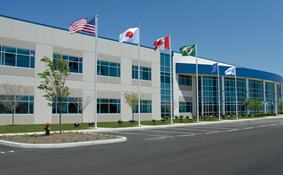 Founded in 1954, Press-Seal Gasket Corporation has grown from a small Fort Wayne operation to a company with international reach, selling to customers in Israel, Sweden, Norway, Mexico, Canada, Japan and some Caribbean countries.
Founded in 1954, Press-Seal Gasket Corporation has grown from a small Fort Wayne operation to a company with international reach, selling to customers in Israel, Sweden, Norway, Mexico, Canada, Japan and some Caribbean countries.
“When I first started as a salesman in 1978, I was just the 13th employee,” relays Chairman and CEO James Skinner, adding the company now has 138 on staff.
Skinner explains the company was initially founded by a concrete pipe producer who wasn’t satisfied with the quality of rubber gaskets available at the time. Ten years later following some deaths in his family, two attorneys serving as the company’s counsel ended up owning the company. They struggled to produce a reliable accounting report, so they called IBM to send a computer salesman out in 1964 to straighten it out.
“My father (Hank Skinner) was working for IBM and was sent out to Press-Seal and explained IBM could not sell them a computer because the company was too small, and the cost of the computer would have been half of its annual revenues.”
He did provide them with a bookkeeping system and a list of accountants who could keep it straight.
“Basically, they were so impressed with him that they offered him part of the business – to come in as general manager,” Skinner says. “Then over the next eight years, my father purchased the interest of the other two stockholders. Since 1964, our family has been involved in the management of the company, and I purchased it from my parents in 1984.”
Over time, the company has expanded from mainly pipe gaskets and pipe-to-manhole connectors, and in 1990 expanded into extrusion and molding. Press-Seal has also added a tool and die operation.
“That’s a similar story to how the company started,” Skinner notes. “I was unable to get good delivery from local tool and die shops because we were a small company and all the larger companies in the Fort Wayne market were their priority. So I bought a small tool and die shop in Columbia City and turned it from a small shop that was servicing the foundry and automotive industries to a shop that focuses on medical, aerospace, automotive and higher tech things. It’s now a fully integrated shop…
“It allows us to take a different tack on how things are made,” he adds, noting that stainless parts are a specialty of the operation. “While a lot of tool and die shops are going out of business these days, we are thriving. We find a lot of customers are in a lot of pain in terms of non-delivery and (a shop) not understanding the customers’ needs.”
Continue reading →
 SMC Corporation of America is the U.S. subsidiary – based in Noblesville – of a Japanese-based company specializing in the manufacturing of pneumatic devices. Think actuators, valves, connectors, temperature control equipment and more.
SMC Corporation of America is the U.S. subsidiary – based in Noblesville – of a Japanese-based company specializing in the manufacturing of pneumatic devices. Think actuators, valves, connectors, temperature control equipment and more.
 Founded in 1954,
Founded in 1954,  There has been plenty of talk lately about high-speed rail. If that talk eventually turns into action and Indiana ends up in the fast lane, all we can say is it’s about time.
There has been plenty of talk lately about high-speed rail. If that talk eventually turns into action and Indiana ends up in the fast lane, all we can say is it’s about time.